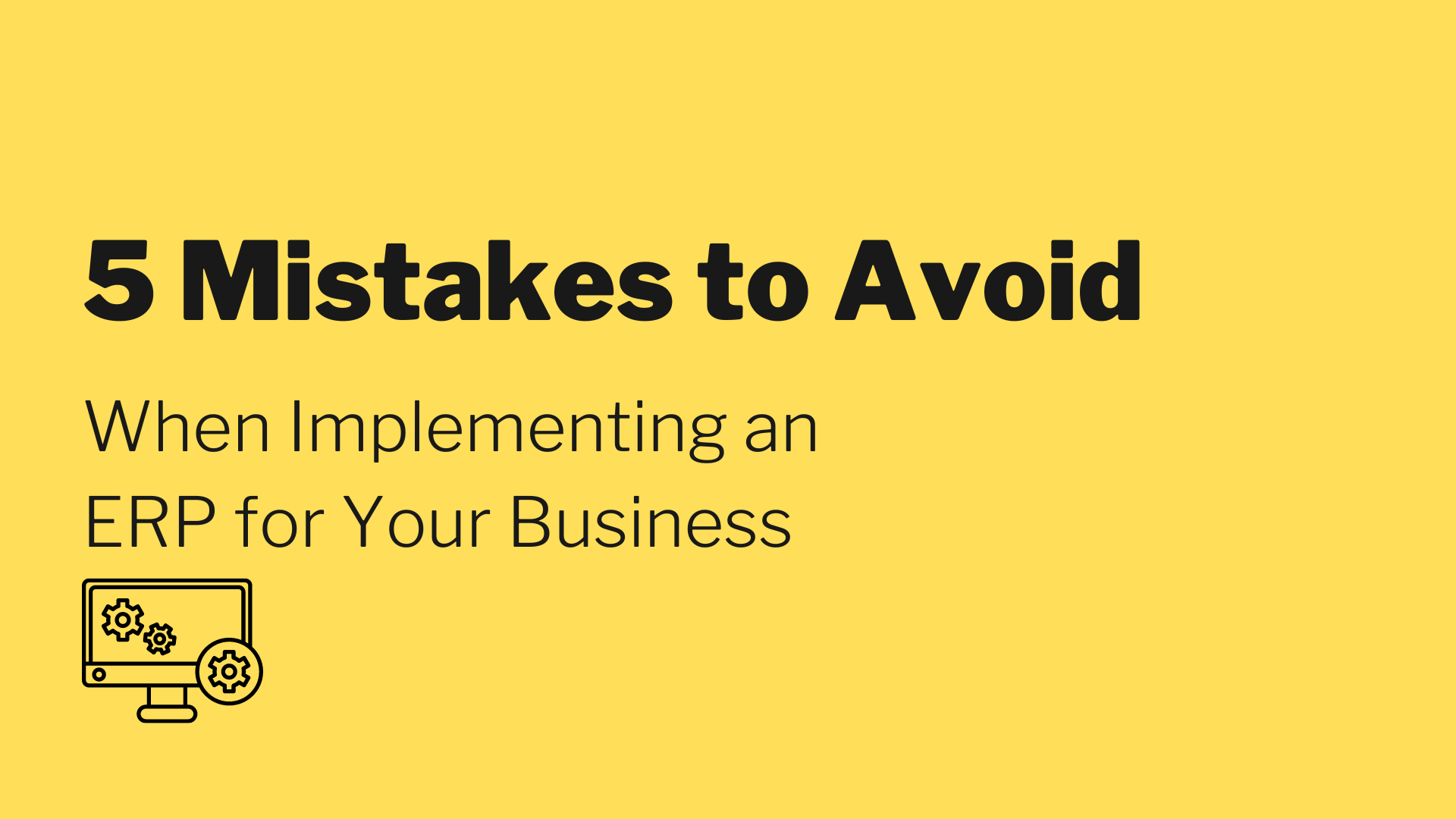ERP is a software solution designed to integrate and manage various aspects of a company's operations, including finance, human resources, supply chain, manufacturing, customer relationship management, and more.

The primary importance of ERP in business lies in its ability to streamline and automate processes, enhance data visibility and accuracy, and facilitate efficient decision-making. However, while implementing an ERP business you must avoid the following 5 mistakes.
This article covers the following:
- Introduction to ERP: Understanding the Basics
- Key Considerations for ERP Implementation
- Selecting the Right ERP System for Your Business
- 5 Mistakes to Avoid When Implementing an ERP for Your Business
- How can Deskera assist you?
Introduction to ERP: Understanding the Basics
In today's rapidly evolving business landscape, managing complex operations and processes efficiently has become crucial for organizations. Enterprise Resource Planning (ERP) systems have emerged as powerful tools to streamline and integrate various aspects of business operations.
ERP stands for Enterprise Resource Planning. It is a software solution that enables organizations to manage and integrate key business functions and processes, including finance, human resources, manufacturing, supply chain management, customer relationship management, and more. ERP systems provide a centralized database and a suite of applications that facilitate real-time information sharing and collaboration across departments.
Key Components of ERP:
Centralized Database: ERP systems store data in a central repository, allowing various departments to access and share information seamlessly. This eliminates data silos and improves data accuracy and consistency.
Integrated Modules: ERP solutions consist of modules tailored to different business functions, such as finance, inventory management, procurement, production planning, and sales. These modules are designed to work together, ensuring a smooth flow of data and processes across the organization.
Reporting and Analytics: ERP systems offer robust reporting and analytics capabilities, allowing businesses to generate insights from their data. By leveraging advanced reporting tools, organizations can make data-driven decisions and monitor performance metrics effectively.
Automation and Workflow Management: ERP automates repetitive tasks and standardizes business processes, reducing manual effort and the likelihood of errors. Workflow management features enable organizations to define and track processes, ensuring tasks are completed efficiently.
Benefits of ERP
Implementing an ERP system offers numerous benefits to organizations, including:
Enhanced Efficiency: By integrating and automating processes, ERP eliminates redundant tasks, streamlines operations, and improves productivity across departments.
Improved Data Accuracy: ERP centralizes data, reducing the risk of inconsistencies and errors that can occur with manual data entry. This ensures data integrity and facilitates reliable decision-making.
Increased Visibility: ERP provides real-time visibility into key business processes, enabling managers to track operations, monitor performance, and identify bottlenecks. This promotes better resource allocation and strategic planning.
Enhanced Collaboration: ERP systems foster collaboration by enabling seamless information sharing and communication across departments. This promotes cross-functional teamwork and improves overall organizational efficiency.
Scalability and Flexibility: ERP solutions can scale as the organization grows, accommodating new business units, processes, and locations. They also offer flexibility to adapt to changing business requirements and industry regulations.
Key Considerations for ERP Implementation
While ERP systems offer significant benefits, successful implementation requires careful planning and consideration of various factors:
Business Process Analysis: Before implementing an ERP system, organizations should conduct a thorough analysis of their existing processes. This helps identify areas for improvement and ensures the ERP solution aligns with their unique requirements.
Customization vs. Configuration: ERP systems can be configured or customized to suit specific business needs. It's important to strike a balance between leveraging out-of-the-box functionality and tailoring the system to meet specific requirements.
Change Management: Implementing an ERP system often entails significant organizational change. Effective change management strategies, including training programs and communication plans, should be in place to support employees through the transition.
Vendor Selection: Choosing the right ERP vendor is critical. Factors to consider include vendor reputation, product features, implementation support, ongoing maintenance, and scalability.
Data Migration and Integration: Organizations must plan and execute data migration from legacy systems to the new ERP system carefully. Integration with existing applications, such as CRM or e-commerce platforms, should also be considered.
Enterprise Resource Planning (ERP) systems have revolutionized the way organizations manage their operations. By integrating and streamlining various business functions, ERP enhances efficiency, improves data accuracy, and provides real-time visibility.
Successful ERP implementation requires careful planning, considering factors such as business processes, customization needs, change management, vendor selection, and data migration. Embracing ERP can position organizations for growth, agility, and sustained success in today's dynamic business environment
How to Determine If ERP is Right for Your Business or Not?
Assess your business needs: Start by understanding your organization's goals, operations, and specific pain points. Identify the areas where an ERP system could potentially bring value, such as streamlining processes, improving data accuracy, enhancing collaboration, or supporting growth.
Conduct a cost-benefit analysis: Evaluate the potential costs associated with implementing an ERP system, including software licenses, infrastructure, training, and ongoing maintenance. Then, consider the benefits it could bring, such as increased efficiency, reduced errors, better decision-making, and scalability. Compare the costs and benefits to determine if the investment is justified.
Evaluate your existing systems: Take stock of your current software and technology infrastructure. If you have multiple disconnected systems that don't communicate effectively, an ERP system might be beneficial in integrating and centralizing your data and processes.
Research available ERP options: Explore the ERP market to find solutions that align with your industry, business size, and requirements. Consider factors such as functionality, scalability, customization options, vendor reputation, customer reviews, and pricing models. Shortlist a few ERP systems that seem like a good fit for your business.
Engage stakeholders: Involve key stakeholders, including management, department heads, IT personnel, and end-users, in the decision-making process. Gather their input and concerns to ensure that their needs are considered. Stakeholder buy-in is crucial for successful ERP implementation.
Request demos and trials: Contact the ERP vendors on your shortlist and request product demonstrations or trial access. This will allow you to assess the user interface, ease of use, features, and functionality. Engage with the software hands-on and envision how it would work within your business environment.
Consider customization and integration: Determine if the ERP system can be tailored to meet your specific requirements. Assess the ease of customization and integration with existing software and systems, such as accounting, CRM, or e-commerce platforms. Compatibility and flexibility are essential.
Evaluate implementation and support: Explore the implementation process and the level of support provided by the ERP vendor. Consider factors such as training programs, data migration assistance, post-implementation support, and the availability of user manuals or knowledge bases.
Consider long-term scalability: Assess how well the ERP system can accommodate your business growth and future needs. Will it be able to handle increased transaction volumes, additional users, and expanding product lines or services? Scalability is important to ensure your investment remains relevant in the long run.
Seek expert advice if needed: If you're uncertain or overwhelmed by the decision, consider consulting with an independent ERP consultant who can provide guidance based on your business's unique needs. They can help assess your requirements, analyze potential solutions, and provide recommendations.
By following these steps, you'll be able to evaluate whether an ERP system is the right fit for your business and make an informed decision. Remember that careful planning, stakeholder involvement, and thorough research are crucial for successful ERP implementation.
How to Select the Right ERP System?
Assess Your Business Requirements
Before embarking on the ERP selection process, it is crucial to evaluate your organization's unique requirements. Conduct a thorough analysis of your business processes, identify pain points, and determine the specific functionalities and features your ERP system should possess. Consider factors such as scalability, integration capabilities, reporting and analytics, industry-specific modules, and compliance requirements.
Set a Realistic Budget
Establishing a realistic budget is an important aspect of selecting an ERP system. Take into account not just the initial software costs but also implementation, training, maintenance, and ongoing support expenses. Determine the return on investment (ROI) you expect from the ERP system and balance it with the financial resources available to your organization.
Research and Shortlist Potential ERP Vendors
Research different ERP vendors and evaluate their offerings based on your business requirements. Look for vendors with a proven track record, industry expertise, and positive customer reviews. Create a shortlist of potential vendors and assess their experience in your industry, the comprehensiveness of their solution, and their ability to provide ongoing support.
Conduct Demonstrations and Evaluate Functionality
Arrange demonstrations with the shortlisted ERP vendors to get a firsthand look at their systems. During these demos, pay close attention to the system's user interface, ease of use, and the availability of key features relevant to your business. Engage your key stakeholders, such as department heads and end-users, in the evaluation process to gather their feedback and ensure their needs are met.
Consider Scalability and Future Requirements
Your ERP system should be capable of accommodating your business's growth and evolving needs. Consider the scalability of the system, its ability to handle increasing data volumes, and support expansion into new markets or product lines. Additionally, evaluate the vendor's product roadmap and future development plans to ensure that the ERP system aligns with your long-term business goals.
Integration Capabilities
Check the ERP system's integration capabilities with other critical software applications your organization relies on, such as CRM, e-commerce platforms, or third-party logistics systems. Seamless integration reduces data silos and enables smooth data flow across different departments, improving overall operational efficiency.
Evaluate Vendor Support and Services
Assess the level of support and services offered by the ERP vendors. Look for a vendor that provides implementation assistance, training programs, and ongoing technical support.
Consider factors such as the availability of helpdesk support, system upgrades, and maintenance services to ensure that your ERP system remains up-to-date and functions optimally.
Check References and Customer Feedback
Request references from the ERP vendors and reach out to their existing customers. Gathering feedback from other businesses that have implemented the ERP system can provide valuable insights into its strengths, weaknesses, and overall customer satisfaction. Consider factors such as vendor responsiveness, implementation timelines, and the ability to address issues promptly.
5 Mistakes to Avoid When Implementing an ERP for Your Business
Implementing an Enterprise Resource Planning (ERP) system can be a significant undertaking for any business. It has the potential to streamline operations, improve efficiency, and provide valuable insights into various business processes.
However, ERP implementation projects are not without their challenges. In order to ensure a successful ERP implementation, it is crucial to avoid common mistakes that can derail the process. In this blog, we will discuss five mistakes to avoid when implementing an ERP for your business.
Insufficient Planning and Preparation
One of the most critical mistakes businesses make is jumping into an ERP implementation without adequate planning and preparation. Before embarking on an ERP implementation project, it is essential to conduct a thorough analysis of your business processes, identify the specific goals and requirements, and create a detailed implementation plan.
Without proper planning, you may encounter issues like scope creep, budget overruns, and delayed timelines, ultimately affecting the success of your ERP implementation.
To avoid this mistake, invest time in gathering requirements, involving key stakeholders, and creating a realistic project timeline and budget. Consider engaging an experienced ERP implementation team or consultant who can guide you through the planning phase and ensure all crucial aspects are addressed.
Lack of User Involvement and Training
User involvement and training are crucial for a successful ERP implementation. Employees who will be using the ERP system need to be actively engaged throughout the process. Involving end-users from the early stages helps in gathering valuable insights, addressing their concerns, and ensuring the system meets their needs.
Moreover, providing comprehensive training to employees is essential to enable them to make the most of the ERP system. Lack of training can lead to resistance, low adoption rates, and underutilization of the system's capabilities.
To avoid this mistake, allocate sufficient time and resources for user involvement and training, and consider developing user-friendly documentation and conducting hands-on workshops.
Customization Overload
While it may be tempting to customize the ERP system to align perfectly with your business processes, excessive customization can be detrimental to the implementation project.
Customizations increase complexity, cost, and the risk of system instability and compatibility issues. Additionally, future system upgrades and maintenance become more challenging and expensive when there are numerous customizations.
To avoid customization overload, carefully evaluate your business processes and determine if they can be adapted to fit the standard functionalities of the ERP system.
Explore alternative solutions like process reengineering or finding best practices within the ERP system that can meet your requirements without customization. Limit customizations to only those that are absolutely necessary for your unique business needs.
Inadequate Data Migration and Testing
Data migration is a critical aspect of ERP implementation, and inadequate planning and execution can lead to significant issues. Insufficient data cleansing, improper mapping, and incomplete data migration can result in inaccurate or incomplete data in the new system. This can impact decision-making, create operational bottlenecks, and cause frustration among users.
To avoid data migration problems, thoroughly assess the quality of your existing data, cleanse it, and ensure compatibility with the ERP system. Develop a robust data migration plan, perform trial runs, and validate the migrated data for accuracy and completeness. Conduct comprehensive testing of all system functionalities to identify and resolve any issues before going live.
Neglecting Change Management
Implementing an ERP system often brings significant changes to the way employees work, and neglecting change management can lead to resistance and low adoption rates.
People are naturally resistant to change, and without effective change management strategies, employees may be reluctant to embrace the new system and processes. To avoid this mistake, establish a change management plan that includes clear communication channels, stakeholder engagement, and training programs.
Involve employees in the decision-making process, communicate the benefits of the ERP system, and address their concerns. Encourage a culture of continuous learning and provide ongoing support to ensure a smooth transition to the new system.
Implementing an ERP system can be a game-changer for your business, but it requires careful planning, user involvement, and a focus on best practices. By avoiding the five common mistakes discussed in this blog—insufficient planning, lack of user involvement and training, customization overload, inadequate data migration and testing, and neglecting change management—you can increase the chances of a successful ERP implementation.
Remember that an ERP implementation is a journey, and investing time and effort into avoiding these mistakes will pay off in the long run, helping you unlock the full potential of your ERP system and drive business growth.
How Can Deskera Assist You?
Deskera ERP and MRP system can help you:
- Manage production plans
- Maintain Bill of Materials
- Generate detailed reports
- Create a custom dashboard

Deskera ERP is a comprehensive system that allows you to maintain inventory, manage suppliers, and track supply chain activity in real time, as well as streamline a variety of other corporate operations.
Deskera MRP allows you to closely monitor the manufacturing process. From the bill of materials to the production planning features, the solution helps you stay on top of your game and keep your company's competitive edge.
Deskera Books enables you to manage your accounts and finances more effectively. Maintain sound accounting practices by automating accounting operations such as billing, invoicing, and payment processing.
Deskera CRM is a strong solution that manages your sales and assists you in closing agreements quickly. It not only allows you to do critical duties such as lead generation via email, but it also provides you with a comprehensive view of your sales funnel.
Deskera People is a simple tool for taking control of your human resource management functions. The technology not only speeds up payroll processing but also allows you to manage all other activities, such as overtime, benefits, bonuses, training programs, and much more. This is your chance to grow your business, increase earnings, and improve the efficiency of the entire production process.
Key Takeaways:
- Before embarking on an ERP implementation project, it is essential to conduct a thorough analysis of your business processes.
- User involvement and training are crucial for a successful ERP implementation.
- While it may be tempting to customize the ERP system to align perfectly with your business processes, excessive customization can be detrimental to the implementation project.
- Insufficient data cleansing, improper mapping, and incomplete data migration can result in inaccurate or incomplete data in the new system.
- Implementing an ERP system often brings significant changes to the way employees work, and neglecting change management can lead to resistance and low adoption rates.
Related Articles:












